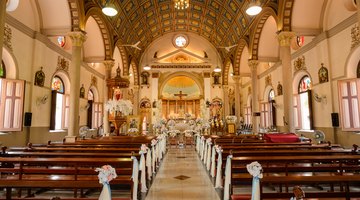What are Different Religious Places of Worship?
A place of worship is a building or other place where people gather to carry out honor and religious praise. According to varying beliefs, the style of religious buildings have changed over many, many years. Religious sites can include places of worship or holy places, but they can vary in meanings for different religions.
The word 'temple' is frequently used as a broad term for a house of worship, the place of worship or a place to hold worship services. Synagogues and churches, however, are not usually referred to as temples. Places of worship include Buddhist and Hindu temples, mosques, synagogues, and churches.
There is a broad range of world religions that use places of worship, from religions in Turkey and Thailand, to those in the Middle East, in India and in Jerusalem. Some of the religions using places of worship are Hinduism, Judaism, Roman Catholic, Sikhism, Zoroastrianism, and many others. Some identifiers for places of worship in many religions can be granth, golden temples, Sikh, bibles, candles, Jews, Arabic language, Masjid, and many other symbols or inclusions of religion.
Buddhist Temples
Buddhist temples are places for personal reverence, ancestor worship, meditation, and offerings for monks and the Buddha. Personal devotion is very significant to Buddhism; it is so important that Buddhists create shrines in their own homes that help believers remember their ancestors and Buddhist texts. Shrines are located in a separate room or a quiet area of the home. The shrine contains an image of Buddha, a vase or tray with flowers, a candle or lamp, incense, a miniature stupa and the scripture.
Mosques
Since their beginnings, mosques have served many purposes. The main purpose of a mosque is to worship and praise Allah. It can be a community building or an open area deemed as sacred. Several mosques have domed roofs with the symbol of Islam, and many of them in Muslim countries have a tower called a minaret. Mosques don't have furniture, statues, or pictures.
Christian Places of Worship
A church is a place where Christians assemble to worship God. Some are very old while others are very modern—any type of building can be used as a church. Areas in the church include the sanctuary, the most holy area; the nave, the main area where people sit; the altar, which is used for the ritual known as the Eucharist or Holy Communion. The pulpit is where the minister gives his/her sermon, and s/he uses the lectern to read the Bible out loud during services. Christian religions or denominations that use churches can range from Catholic, Protestant, Non-denominational, and other different religions. Catholic churches are normally elaborate in design and architecture.
Jewish Places of Worship
A Jewish place of worship goes by several names: shul, beit, congregation and Temple. Synagogue is the most general term and the most recognized. The most significant item in a synagogue is the ark, a cabinet or container that holds the Torah scroll. The ark symbolizes the Holy of Holies, and it is the most sacred place in a synagogue and the prime focus of prayer. During particular prayers, the ark's doors or curtain can remain open or closed.
Hindu Places of Worship
In the Hindu religion, everyday worship occurs in three places: in one's home, in a temple, or on a streetside shrine. Most households have a small shrine dedicated to the gods that are significant to that house. If there is a guru, a photo is present to remind the individual of the guru's teachings. In the temple, the god or goddess are regarded as royalty. The statue is bathed and dressed, and meals and other gifts are frequently provided. Small shrines to Hindu gods and goddesses can be found on roadsides and on streets. They can stay there permanently and untended or be put on a cart and moved around.
Related Articles
References
Writer Bio
Jamie Fleming is a freelance writer based in Georgia. She has a Bachelor of Arts in mass communication and has five years of writing experience. Her work has appeared in publications like "The Savvy Gal" and "Young Money." She is also a writer for Chic Star Entertainment and Mahogany Butterfly.










